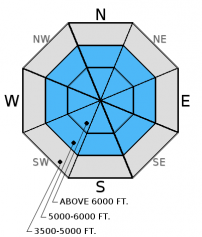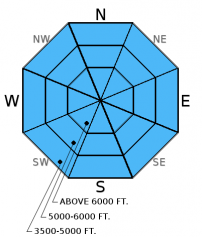| Thursday | Thursday Night | Friday | |
|---|---|---|---|
| Cloud Cover: | Rain and snow with rising snow levels to 6000 feet. | Continued precipitation with lowering snow levels late tonight. | A brief break in precipitation before another moist system enters in the afternoon/evening. |
| Temperatures: | 37 to 51 deg. F. | 24 to 30 deg. F. | 36 to 53 deg. F. |
| Wind Direction: | Southwest | Southwest | South |
| Wind Speed: | 15-25 mph with gusts to 40 mph. | 10-15 mph with gust to 35 mph. | 5-10 mph. |
| Snowfall: | 0-3 in. | 1-2 in. | 0 in. |
| Snow Line: |
Whitefish Range
Swan Range
Flathead Range and Glacier National Park
How to read the forecast
A warm, wet storm has increased the danger to CONSIDERABLE above 5000 feet. Snow, rain on snow, and strong winds will create dangerous avalanche conditions. Both wet and dry avalanche problems exist today. Human triggered and potentially natural storm and wind slabs can be expected to release on a rain crust. Loose wet avalanches are likely as snow levels rise. Buried surface hoar 1.5 to 2 feet from the surface could be a problem in some locations as well.

3. Considerable
?
Above 6500 ft.
3. Considerable
?
5000-6500 ft.
2. Moderate
?
3500-5000 ft.
- 1. Low
- 2. Moderate
- 3. Considerable
- 4. High
- 5. Extreme
-
Type ?
-
Aspect/Elevation ?

-
Likelihood ?CertainVery LikelyLikelyPossible
 Unlikely
Unlikely -
Size ?HistoricVery LargeLargeSmall

Both storm and wind slab avalanches will become more likely as the day progresses. As temperatures warm today heavy, wet snow will fall on lighter, drier snow from the previous 48 hours creating an upside down snowpack. This all sits atop a rain crust to at least 6500-7000 feet in most locations. This rain crust provides a great bed surface for storm and wind slabs to slide on as well. Cautious route-finding, conservative decision making, and careful snowpack evaluation will be essential today. Stick to low angled terrain today and be aware of your location in runout zones beneath steep slopes.
-
Type ?
-
Aspect/Elevation ?

-
Likelihood ?CertainVery LikelyLikelyPossible
 Unlikely
Unlikely -
Size ?HistoricVery LargeLargeSmall

Rain to 6500 feet today will fall on new snow, old snow, and an older rain crust. Human triggered and natural loose, wet avalanches are likely today. The rain crust exists in most places to at least 6500-7000 feet and will provide a bed surface for loose, wet avalanches to run on. Avoid slopes 35 degrees and steeper to avoid this problem today.
-
Type ?
-
Aspect/Elevation ?

-
Likelihood ?CertainVery LikelyLikelyPossible
 Unlikely
Unlikely -
Size ?HistoricVery LargeLargeSmall

Persistent slab avalanches have not yet been a problem, but could become one today with additional snow and rain. A layer of buried surface hoar 1.5 to 2 feet from the surface exists in a few locations (video). It appears to be most prevalent and reactive in stabilty tests in the Whitefish Range, but cannot be ruled out in the other ranges. Yesterday, this layer fractured and propagated in almost all of our locations/snow pits on multiple aspects, and Todd found this layer to propagate in his stability tests last weekend in the southern Whitefish Range. This problem appears to be isolated, but could begin to rear its ugly head today. This emphasizes the importance of digging into the snow and doing stability tests. The layer can be identified by a grey stripe in your snowpit sitting on top of a crust about 1.5 to 2 feet from the surface.
Additional Concerns: As we approach spring and daily maximum temperatures rise above freezing, cornices will likely become more sensitive and glide cracks could begin to fail. Cornices can trigger slab avalanches on the slopes below making the consequences more severe. Skiers in the Swan Range noted a large slab avalanche triggered by a cornice fall last Friday (observation). Give cornices a wide berth while traveling along ridges and limit your exposure time when traveling below them.
Avalanche Danger Scale: The National Avalanche Center developed a great video for helping backcountry users visually understand the avalanche danger scale (video).
We are saddened to hear about a fellow avalanche professional being killed in an avalanche on March 8 in the Wallowa Mountains in Oregon. Our thoughts are with the family and friends of Kip Rand and those at the Wallowa Avalanche Center (info).
Wednesday: My partner and I traveled to Red Meadow Peak in the northern Whitefish Range where we found up to 5 inches of low density snow sitting atop a firm rain crust all the way to 7500 feet. We also found buried surface hoar up to 2 feet from the surface that fractured and propagated in stability tests (observation, video). We noted wet, loose avalanche debris from the weekend, but no new avalanche activity.
Monday: Mark visited Rescue Creek in the Flathead Range and found evidence of a wet loose avalanche cycle from the weekends warm rainy weather. We also noted 2 glide cracks that had formed and a surface rain crust at all elevations (observation).
Saturday: Skiers in the Swan Range noted a cornice failure that triggerred a wind slab avalanche on an upper elevation slope. They also noted sevcral glide cracks that had increased in size during their 4 day tour, including one that had failed (observation). Snow bikers were in the Red Meadow area in the northern Whitefish Range and observed natural loose, wet avalanche activity in the afternoon (photo). They also noted southwest winds cross-loading slopes and increasing the size of cornices in the area. We were on Skookoleel Ridge in the southern Whitefish Range, and in isolated areas we found buried surface hoar about 14 inches from the surface (photo). Stability test results were variable due to variability in slab formation above.
Visit our Observations page and our You Tube channel for more observations from the entire season.
Thanks to everyone for submitting observations. They are extremely useful and could help save lives.
HOW TO SUBMIT OBSERVATIONS:
Email: [email protected]
Call and leave a message: 406.387.3821
You can also submit quick observations via text: 406.241.4571 (FAC mobile)
OR
Submit Snowpack Observations: http://www.flatheadavalanche.org/node/add/snowobs
Submit Avalanche Observations: http://www.flatheadavalanche.org/node/add/avyobs
2-6 inches of snow accumulated above 5000 feet in the past 24 hours. Temperatures began to rise early this morning. Currently, mountain temperatures range from 27°-33° F with southwest winds moving at 7-15 mph and gusting to 22 mph. Rain level is around 4500-5000 feet, but is expected to rise to 5500-6500 feet with warming temperatures today. Precipitation amounts should range from 0.6 to 1.0 inches of snow water equivalent (SWE). Big Mountain Summit station already recorded 0.54 inches of SWE since midnight. This translates to up to 8 inches of snow above 6000 feet and rain below. Wind speeds will increase to 15-25 mph with gusts to 50 mph along the ridges. Precipitation should taper by evening with a brief break tomorrow before picking up again Friday night.
| 0600 temperature: | 27 to 33 deg. F. |
| Max. temperature in the last 24 hours: | 27 to 34 deg. F. |
| Average wind direction during the last 24 hours: | Southwest |
| Average wind speed during the last 24 hours: | 2-18 mph |
| Maximum wind gust in the last 24 hours: | 20-31 mph |
| New snowfall in the last 24 hours: | 1-4 inches |
| Total snow depth: | 73-99 inches |
This advisory applies only to backcountry areas outside established ski area boundaries. This advisory describes general avalanche conditions and local variations always occur. This advisory expires at midnight on the posted day unless otherwise noted. The information in this advisory is provided by the USDA Forest Service who is solely responsible for its content.




































